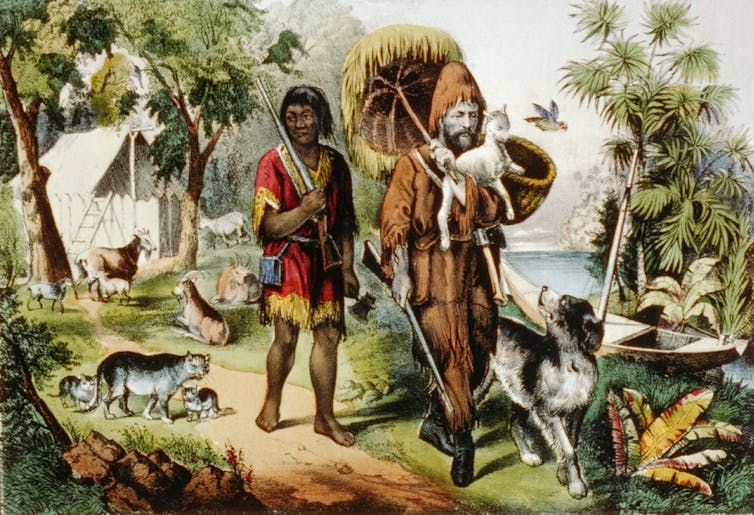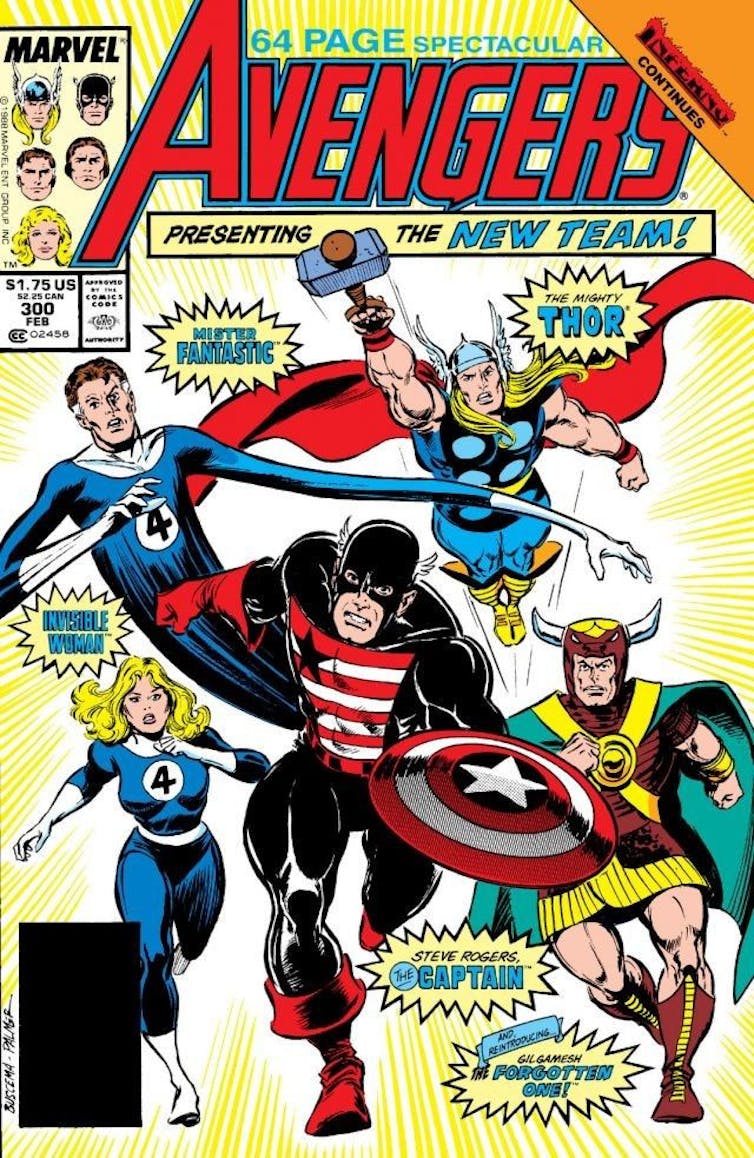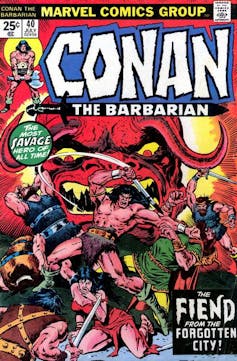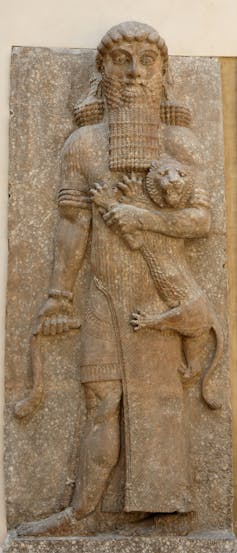
Everett Historical via Shutterstock
Daniel Cook, University of Dundee
A major new series on 100 Novels that Shaped Our World has been launched in the UK by the BBC. The wide-ranging journey through English literary history takes as its starting point the publication of The Life and Strange Surprising Adventures of Robinson Crusoe (1719), which has been hailed as the first English novel.
Despite an error-ridden plot and numerous structural quirks, Robinson Crusoe – which tells the story of a shipwrecked mariner – has had a profound impact on global literature (and the modern world at large) for the past 300 years. Despite the wealth of prose narrative that existed beforehand, some scholars believe that Daniel Defoe’s book was the first to combine all the elements that have become the hallmarks of the novel.
Fiction masquerading as fact, it is so much more than a novelisation of the true-life misfortunes of Alexander Selkirk, a Scottish mariner who spent four years and four months as a castaway at sea after being marooned on an island by his captain. Daniel Defoe’s novel is a gritty survival story with genuine threat. But it’s also a thought-provoking parable of Christian sin, a critique of capitalist individualism, an expose of imperialist paranoia, and even a tale of the triumph of the human spirit.
From the point of view of the natives, it’s a myth of invasion – Crusoe is a sunburned demon who imposes European belief systems on them. There’s no getting beyond the fact that Friday, a man the narrator “saves” from the hands of the cannibals and takes under his wing, is cloyingly subservient to the unkempt foreigner, which upholds a racist ideology of white supremacy (whether it’s Crusoe’s or the author’s own). But we might think of Friday as the true hero. His humility and grace under pressure can serve as a compelling model for anyone in any culture. And his apparent feebleness is the only logical response to seeing for the first time the explosive effect of a fully loaded gun.
Then there’s Xury, a cheerful and charming lad whom Crusoe casually sells to a Portuguese captain (on the apparently agreeable grounds that after ten years of service, and a conversion to Christianity, the boy will be freed). Prior to that, Xury had faced his own terrible choice: subject himself to Crusoe’s will or be tossed overboard. This all happens shortly before Crusoe is shipwrecked. Instant karma, perhaps?

Georgios Kollidas via Shutterstock
Defoe is certainly the master of visual motifs – and Crusoe’s gun is an especially potent one: it at once demonstrates the technological superiority of the Europeans, while signalling their moral deficiencies. After all, warfare does not a true civilisation make.
Seven years later Jonathan Swift spoofed the motif in Gulliver’s Travels, where the miniature protagonist ludicrously boasts of Britain’s prowess in modern weaponry to an astonished audience of gentle giants. Like Gulliver, Crusoe embodies the failings of his home society, even when stranded in strange lands.
Big footprints
The most terrifying moment in Defoe’s story, however, occurs when no one is around. Crusoe stumbles across a footprint in the sand on his seemingly deserted island. The footprint causes a profound crisis of consciousness. Who left it: a friend or foe? Man or monster? Will he be saved or brutally attacked? He’s never more alone than when the threat of uncertain human interaction looms. It’s a scene that has been retold throughout world culture for centuries.
Maxine Hong Kingston’s 1980 short story collection, China Men, a densely woven tale of the lives of Chinese immigrants in America, features a story about a sailor named Lo Bun Sun, who is seized by a debilitating fear when he stumbles across a human footprint on a beach. Even after the wind and rain had worn away the footprint, he continues to be haunted by it – it’s a poignant parable about the ceaseless emotional turmoil of an immigrant’s experience, perhaps, or even an ironic take on colonial exclusionism.
The scene is replayed for laughs in Willis Hall’s children’s book Vampire Island. Count Alucard, Skopka the wolf, and Peppina the parrot lazily loll on a marooned island – until they discover an unfeasibly large bootprint in the sand, which, we eventually learn, belongs to Frankenstein’s monster.
‘Robinsonades’: a cult is born
Defoe’s story of the 17th-century shipwrecked sailor is so famous it has led to the creation of a large and loose genre known as the “Robinsonade” – to which authors as diverse as James Gould Cozzens and John Maxwell Coetzee have contributed. A quick definition might call it a narrative in which a sole protagonist (the notional “Robinson” after whom the genre is named) is suddenly isolated from the comforts of civilisation, usually on an inhospitable island or planet.
But a Robinsonade does not have to be a novel: the principal characters, themes and settings of Robinson Crusoe have always been reworked into non-fictional genres, poems, plays, pantomimes, films, advertisements, and material culture at large.
Outside of literature, the most famous modern example is Cast Away, the 2000 movie starring Tom Hanks as Chuck, a hands-on FedEx executive. Stranded on a deserted tropical island for four years, Chuck desperately seeks to return home to the arms of his girlfriend Kelly (played by Helen Hunt) who, heart-wrenchingly, has mourned and moved on.
Chuck could not be more different from the workshy Crusoe who – despite claiming to be a keen advocate of the Protestant work ethic that shaped England’s economic progress – had rejected the cautions of his wise and grave father in the pursuit of adventure. Paranoid, guilty, hypocritical, and much more besides, Crusoe is not a hero. But he established the model of the flawed protagonist that remains so central to English culture.![]()
Daniel Cook, Senior Lecturer in English, University of Dundee
This article is republished from The Conversation under a Creative Commons license. Read the original article.




